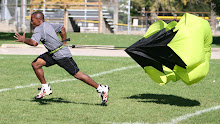
Any athlete training for success should track their training in a written, documented format! Using a log book is a great way to track your training from workout to workout. There are several great reasons for tracking your workouts using the written word.
Tracking workouts allows your to measure your progress when it comes to training loads, conditioning distances, exercises and drills. It enables an athlete to look back over previous workouts for strengths, weakness', and to review past exercises/drills to possibly do again (or NOT do again!)
Things that should be tracked in a workout log include (but is not limited too:)
- Sets, reps and load weight of a specific exercise.
- Rest interval between sets
- Distance athlete sprints, hops, runs, jogs, etc.
- Specific exercise and drills (ea.: squat, plyometrics, bungee jumps, bench presses)
- Training location, date and time
There are a lot of great workout journals on the market today (such as the featured "Ultimate Workout Log" by Suzanne Schlosberg), but honestly, any note book will do. Simple break your page down to feature the columns you desire such as:
- sets, reps, and amount of weight
- exercise or drill type
- performance tool used (Dumbbell, parachute, med ball, etc.)
- workout goal that session (total body, plyometric, etc.)
There are lots of other columns that can be used and added, but this gives you the general idea. However there is one rule----no substituting a computer for a log book! Tracking of your workouts as you train makes it more personal and less "clinical" as if it's being done in a lab as opposed to grinding away in a workout facility.
Train and Track it!








No comments:
Post a Comment